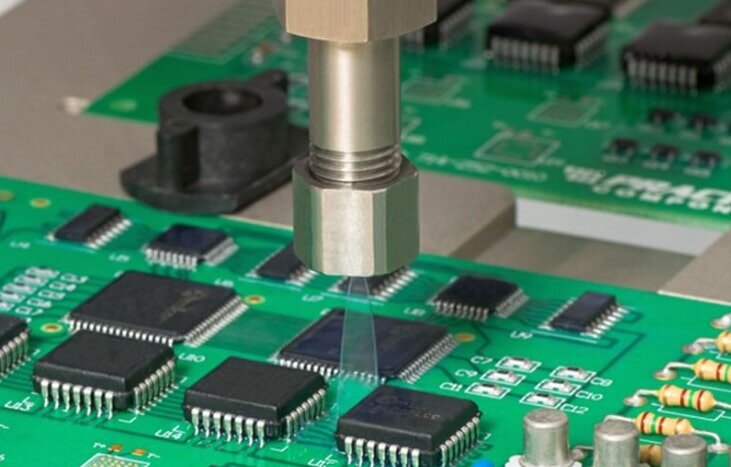Conformal coating refers to covering the surface of electronic equipment with a thin protective film designed to protect circuit boards and components from external environmental factors such as moisture, dust, chemicals and other corrosive substances. With the continuous miniaturization and high performance of electronic products, conformal coatings play an increasingly important role in the electronics industry, especially in aerospace, automotive, medical equipment and other areas requiring high reliability.
Conformal coatings are categorized into UV curing, thermal curing, moisture curing, electric curing and air curing according to the curing method, among which light-curing conformal coatings have the advantages of fast curing speed, applicability to heat-sensitive substrates, low initial investment, reduction of solvent evaporation, low operating cost and space saving. In addition, light-curing conformal coatings meet the requirements of environmental protection, so the development is rapid. However, there are several disadvantages of light curing (1) curing depth is limited, (2) in the colored system is difficult to apply, (3) the shadow part can not be cured, curing the shape of the object is limited.
PCB surface plug-in complex, only light curing will affect the plug-in shadow part of the curing effect, so the research and development of conformal coatings are used in light, dark conditions can be cured double curing mechanism, which can ensure that most of the areas on the PCB rapid curing, to facilitate the implementation of the subsequent process, but also ensure that a small number of shaded areas in the short term curing completely, not only to improve the production efficiency of the circuit board coating, but also to ensure that the conformal The coating of the complete curing, can be applied to a variety of complex types of circuit board coating protection. Common double curing are light-heat curing, light-moisture curing, light-chemical curing and light-chemical-air curing.
You will find five common types of conformal coatings commonly used on PCBs.
These coating types have unique properties and can be used under different conditions.
They include:
Acrylic Resins: These coatings are widely used for their flexibility and ease of application and removal.
Poly paraxylene resins: you find these resins based on paraxylene and are typically used under vacuum conditions.
Polyurethane resins: these resin types can also be found as two-part combinations. They have relatively long curing times and impressive resistance to chemical attack.
Silicone Resins: Silicone coatings have excellent durability properties and a transparency suitable for solar functionality.
These coatings cannot be removed using solvents because they are not soluble in them.
Epoxy resins: These coatings exhibit excellent resistance to physical, moisture and chemical intrusion.
They can be applied by all available techniques but are difficult to remove.

conformal coating
Conformal coatings on circuit boards
Conformal coating is a coating used to protect PCBs from external environmental factors such as moisture, dust, and chemicals. It improves the reliability and longevity of the circuit board by forming a protective film on the surface of the board. The following is the specific application process and role of conformal coating on the circuit board.
1. Conformal coating application process
The application of conformal coatings is usually divided into several steps: preparation, coating, curing and inspection.
Preparation: The first step is to clean the surface of the board to remove grease, dust and impurities. This is a critical step to ensure good adhesion of the coating. After that, masking tape or film is used to protect areas that do not need to be coated, such as connectors or slots.
Coating: There are various methods of coating, the common ones being spraying, brushing, dip coating and flow coating.
Spraying: Suitable for large-scale production, the coating is evenly sprayed onto the surface of the board by means of a spray gun.
Brushing: Suitable for small batch production, manual operation is relatively simple.
Dip coating: The board is immersed in the coating solution, which is suitable for thicker coatings.
Curing: After the coating is applied, it needs to be stabilized by a curing process. Common curing methods include heat curing (high temperature baking), UV curing, and air drying. Different types of coatings cure in different ways.
Inspection: After curing, the quality of the coating needs to be inspected, such as thickness uniformity and the presence of bubbles or cracks.
2. Role of Conformal Coating
The main functions of conformal coating on circuit boards include the following:
Anti-moisture and anti-corrosion: Conformal coating can prevent the circuit board from moisture and corrosion, especially in humid environments, can effectively protect the circuit board from moisture.
Dust protection: The coating prevents dust and small particles from entering the circuit board and reduces failures caused by dust buildup.
Electrical isolation: Conformal coatings also provide some electrical insulation, reducing problems caused by current leakage and electrostatic discharge.
Improved Mechanical Strength: The coating enhances the board's resistance to vibration and shock, especially in areas such as industry or automotive, and can effectively prevent the board from being damaged in a vibrating environment.
Extend service life: By protecting the circuit board from environmental factors, conformal coatings can significantly extend the service life of the circuit board and reduce the failure rate.
The application of conformal coatings on circuit boards is crucial to provide reliable protection for circuit boards, enabling them to operate stably in complex and demanding operating environments. Through proper coating methods and process control, conformal coatings can enhance the protective properties of circuit boards, extend their service life, and ensure the high reliability of electronic equipment. As a result, conformal coatings have become an integral part of the electronics manufacturing industry and are widely used in consumer electronics, automotive electronics, industrial controls, medical devices, aerospace and many other fields.